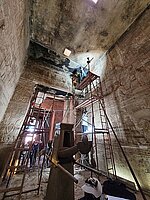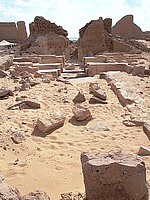Finds from Egyptian Temples: On Tradition, Economy, and Identity Formation in a Multicultural Context

Egyptology deals with the entire range of material and spiritual legacies that have come down to us from the ancient Egyptians. Egyptology uniquely combines philological and archaeological study of an ancient culture. The Chair for Egyptology at the University of Würzburg also has several research projects underway, including two on Egyptian temples.
Diving into the Heart of an Egyptian Temple: Sanctuary and Mesenit of the Horus Temple of Edfu
Sanctuary and Mesenit are two rooms that form the innermost core of the Temple of Horus at Edfu. However, the function and conception of the symbolic rooms have not been sufficiently systematically analyzed so far. The current project at the Würzburg Egyptology therefore comprises a detailed and comparative study of the Horus temple of Edfu (Upper Egypt, 237-57 B.C.), especially of its wall reliefs. The latter, through their detail, provide exciting insights into the rituals performed at the time, the inventory of the temple, but also into the (supra)regional cult topography, mythology, iconography and theological concepts of the time.
By incorporating current research, the six-year project, divided into two phases, will provide a foundation for future studies of the entire sanctuary, its theology, and its cult operations. The reliefs that have been made accessible will be documented, analyzed and contextualized through photographs and drawings, and will be made available to the public.
The Temple of Dime: What Writings Tell Us About Egyptian Identity in Roman Egypt
The Temple of Soknopaios at Dime is a temple in the Egyptian desert that was abandoned as late as 250 AD due to silting up, salinization of the water, and desertification. It is the centre of the village Dime on the northern edge of the Fayum Oasis in Egypt. The temple is particularly well known in Egyptology not so much for its reliefs (as the completely preserved temple in Edfu) but for its well-preserved papyrus finds. These allow an insight into the economic structure of an Egyptian temple in the first post-Christian centuries, which were shaped by the religion and theology of the sanctuary in Roman times.
Within the framework of the project, which also lasted six years, information about the daily rituals and mythology of the Egyptians of this time will be collected and related to the cult as well as the history and chronology of the temple. The interconnection of partial results and the edition of unpublished sources provide information about Egyptian identity, especially in times of Roman rule.
Romans Responsible for the Decline of Temples in Egypt? DimeData Revises Outdated Views
Contrary to the view assumed in past research that the Romans were to blame for the decline of Egyptian temples, today it is considered that Rome even provided economic stimulation in Egypt. Therefore, it is obvious to use the temple of Dime for current investigations because of the already mentioned abundance of textual sources from the Roman period in Egypt.
The online edition platform DimeData is an economic case study in the form of a corpus that uses the accounting texts of the Roman-period temple of Dime to analyze economic life at the time. In the process, 40 of the approximately 800 well-preserved unpublished copies will be consulted and re-edited for the project. The project aims to put our knowledge of the economic life of Egyptian temples in the Roman Imperial period on a new basis.

Contact & Links
Prof. Dr. Martin Andreas Stadler holds the Chair for Egyptology at the University of Würzburg.









